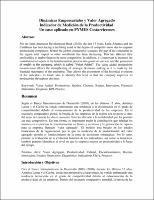| dc.contributor.author | Leandro Elizondo, R. | |
| dc.contributor.author | Calderón Ortega, E. | |
| dc.contributor.author | Gamboa, O. | |
| dc.date.accessioned | 2021-05-27T15:56:07Z | |
| dc.date.available | 2021-05-27T15:56:07Z | |
| dc.date.issued | 2013 | |
| dc.identifier.uri | https://hdl.handle.net/20.500.13048/959 | |
| dc.description.abstract | For the Inter-American Development Bank (2010), the last 15 years, Latin America and the Caribbean has been facing a declining trend in the degree of competitiveness due to stagnant productivity companies. Within the global comparative scenario, the gap of the companies in the region with respect to other worldwide has been increasing. This has affected their profitability to enable them to be more competitive. In addition, it´s important to measure the contribution of inputs in the transformation process into goods or services and the generation of wealth to the company, which is called “Value Added”. The value added productivity measurement allows the strengthening of strategic decisions making as it is made by the financial statements of the enterprise. Thus allows the assessment of the historical evolution of the indicators, its trend; also to identify this level in that the company improves its productivity throughout the time. | |
| dc.description.abstract | Según el Banco Interamericano de Desarrollo (2010), en los últimos 15 años, América
Latina y el Caribe ha estado enfrentando una tendencia a la disminución en el grado de
competitividad debido al estancamiento de la productividad de las empresas. En el
escenario comparativo global, la brecha de las empresas de la región con respecto a otras
del resto del mundo ha ido en aumento. Esto ha afectado a la rentabilidad que les permita
ser más competitivos. De esta forma, es importante medir la contribución que brindan los
insumos en el proceso de transformación en bienes y servicios y la generación de riqueza
para la empresa, llamado "valor agregado". El modelo está basado en los estados
financieros de la organización por lo que la medición de la productividad del valor
agregado permite el fortalecimiento de la toma de decisiones estratégicas. Por lo tanto, permite la evaluación de la evolución histórica de los indicadores, así como su tendencia,
también permite identificar el nivel en que la empresa mejora su productividad a lo largo
del tiempo. | |
| dc.language.iso | spa | |
| dc.rights | info:eu-repo/semantics/openAccess | |
| dc.rights | Atribución-NoComercial-SinDerivadas 2.5 Perú | |
| dc.rights.uri | http://creativecommons.org/licenses/by-nc-nd/2.5/pe/ | |
| dc.subject | Valor Agregado | |
| dc.subject | Productividad | |
| dc.subject | Calidad | |
| dc.subject | Encadenamientos | |
| dc.subject | Kaizen | |
| dc.subject | Innovación | |
| dc.subject | Estados Financieros | |
| dc.subject | Diagnóstico | |
| dc.subject | Indicadores Clave | |
| dc.subject | Procesos | |
| dc.title | Dinámicas Empresariales y Valor Agregado Indicador de Medición de la Productividad. Un caso aplicado en PYMES Costarricenses | |
| dc.type | info:eu-repo/semantics/conferenceObject | |
| dc.relation.conferencedate | 27-31 de octubre, 2013 | |
| dc.relation.conferencename | XV Congreso Latino-Iberoamericano de Gestión Tecnológica | |
| dc.relation.conferenceplace | Porto, Portugal | |
| dc.contributor.corporatename | Tecnológico de Costa Rica | |


